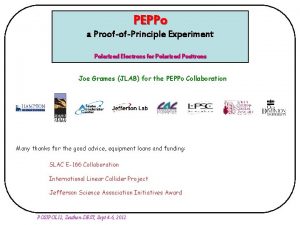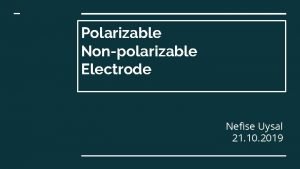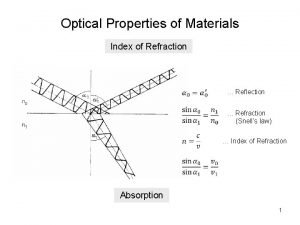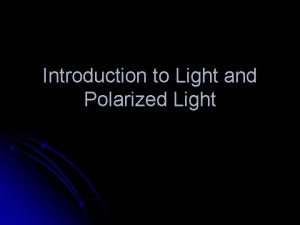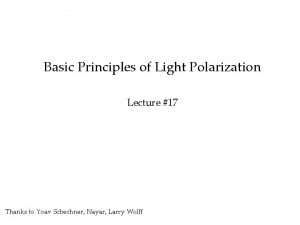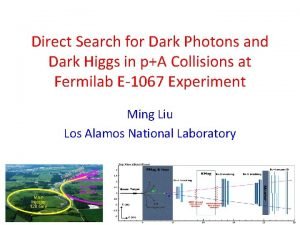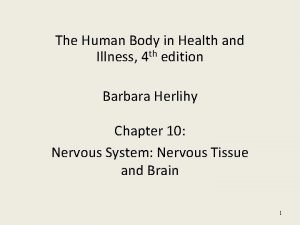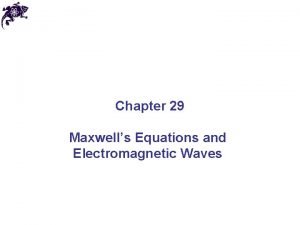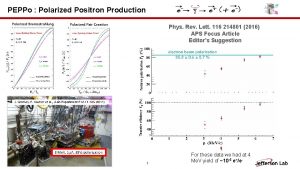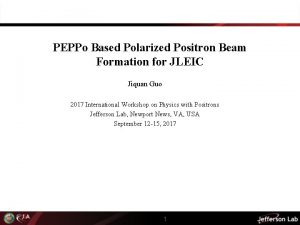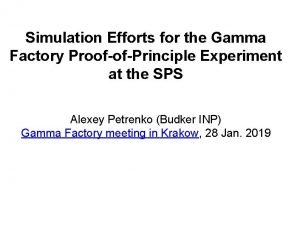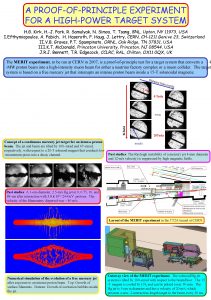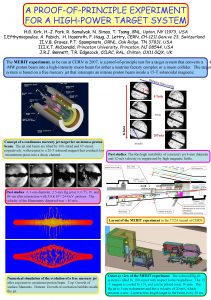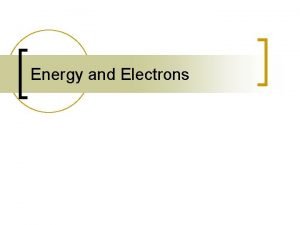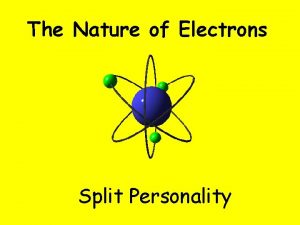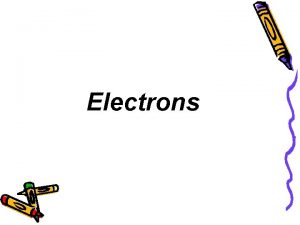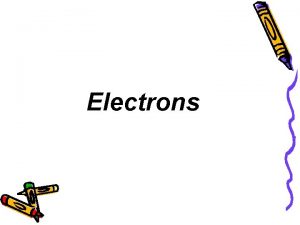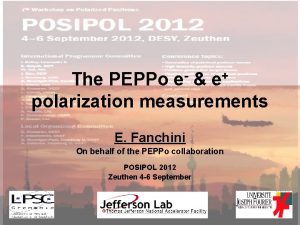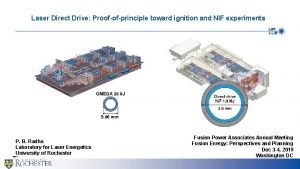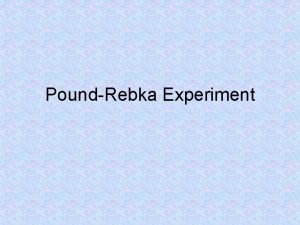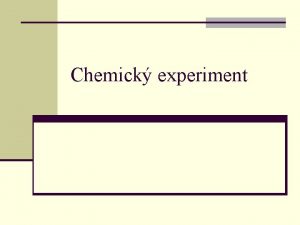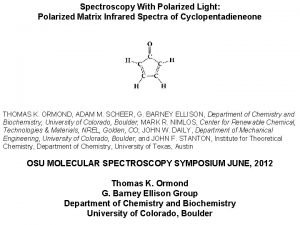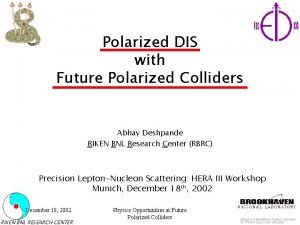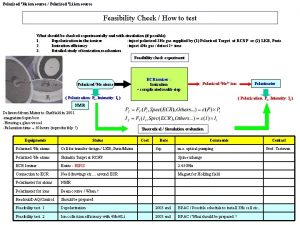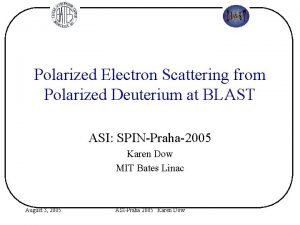PEPPo a ProofofPrinciple Experiment Polarized Electrons for Polarized































- Slides: 31

PEPPo a Proof-of-Principle Experiment Polarized Electrons for Polarized Positrons Joe Grames (JLAB) for the PEPPo Collaboration Many thanks for the good advice, equipment loans and funding: SLAC E-166 Collaboration International Linear Collider Project Jefferson Science Association Initiatives Award POSIPOL 12, Zeuthen-DESY, Sept 4 -6, 2012

Continuous Electron Beam Accelerator Facility CW Electron beam in all Halls Polarization: 85 -90% Max Energy: 11 Ge. V(ABC) / 12 Ge. V(D) Max Current: 200 m. A 3 existing end stations for nuclear physics experiments would benefit from a beam of polarized positrons: q Parton Imaging q Deeply Virtual Compton Scattering q Two Photon Exchange Other efforts may also benefit: q Electron Ion Collider q Materials Science Collaborations

CEBAF Polarized Electron Injector Polarized Electron Source (130 k. V) SRF Acceleration (60/126 Me. V) Synchronous Photoinjection 5 Me. V Mott Polarimeter Chopper Apertures Cryounit Buncher Synchrotron Light Monitor Cryomodules Capture H-Wien Filter Gun#3 V-Wien Filter Spin Solenoids Pre. Buncher Gun#2 Electron Spin Manipulation FC#1 Bunchlength Cavity Injection Chicane FC#2 Spectrometer Dump 100/500 ke. V Mott Polarimeter Bunching & Acceleration 500 ke. V SRF Acceleration (10 Me. V)

CEBAF Energy Compatibilities CEBAF Pre-Injector CEBAF 6 Ge. V Injector CEBAF 12 Ge. V Injector Conversion efficiencies are low, but 100 n. A – 10 m. A sufficient for user requirements Corresponding milliamp electron beams are challenging, yet possible (more later).

Polarized Bremsstrahlung & Pair Creation E. G. Bessonov, A. A. Mikhailichenko, EPAC (1996) A. P. Potylitsin, NIM A 398 (1997) 395 e- → g → e+ E. A. Kuraev, Y. M. Bystritskiy, M. Shatnev, E. Tomasi-Gustafsson, PRC 81 (2010) 055208 Bremsstrahlung Pair Creation

PEPPo Concept @ JLab S 1 Pee- T 1 D PEPPo o Longitudinal e- (Pe-) produce elliptical g whose circular (Pg) component is proportional to Pe-. o Pg transfers to e+ into longitudinal (Pe+) and transverse (Pt) polarization components. On the average Pt=0. Ie = 1 µA T 1 = 1 mm S 2 D Pt e+ T 2 Calorimeter PEPPo is proposing to measure the polarization transfer from longitudinal electrons to longitudinal positrons in the 3 -7 Me. V/c momentum range.

PEPPo Lobbying (2009 -2011) It followed PAC 35’s enthusiastic endorsement of LOI-10 -010 which noted that “Any accelerator facility, like JLab, using polarized electrons for its physics program would like an intense beam of polarized positrons. This Letter marks a proof of principle experiment that should become a full proposal. ” The PEPPo experiment (PR 12 -11 -105) proposes to measure the polarization transfer from longitudinally polarized electrons to longitudinally polarized positrons as a proof-of-principle for a new technique for polarized positron source. In August 2011 PAC 38 recommended to run PEPPo with an “A” rating

The PEPPo experiment @ JLab Viewers Beam position monitors Solenoid ELEGANT beam optics Viewers Collimator Polarized Analyzing Target (7. 5 cm Fe) Solenoid Dipoles Corrector magnets PEPPo branch jonction Quadrupoles G 4 PEPPo experiment model Production Target T 1 (0. 1 -1 mm W) Faraday Cup Annihilation detector Viewer Positron Selection Device Corrector magnets Reconversion Target T 2 (2 mm W) Beam Profiler Compton Transmission Polarimeter

Positron Production. Target Ladder • Target ladder with viewer + 3 conversion targets e-

Installation Complete November, 2011

Experiment Strategy q Beam line calibration, positron production & collection q Calibrating Compton polarimeter with polarized electrons q Measuring polarization of collected positrons

Beam line Tune-up & Check out Target Ladder Electron Extraction Spectrometer Midpoint Spectrometer Exit Vacuum Exit

Electron Momentum Calibration • Vary cryounit gradient and use electron spectrometer to measure momentum of beam tro c pe S n tro c Ele • Use known momentum to determine corresponding spectrometer setpoint • Compare with G 4 Beamline using magnetic mapping r te me

Collection of Degraded e- and Pair-Produced e+ “S 1 – Capture Solenoid” “SPEC – spectrometer” “S 2 – Transport Solenoid” Faraday Cup S 1 [Amps] S 2 [Amps]

Collection: Degraded Electrons then Positrons “S 1 – Capture Solenoid” “SPEC – spectrometer” “S 2 – Transport Solenoid” Faraday Cup • Spectrometer setpoint determined from momentum calibration • Capture (S 1) and Transport (S 2) setpoints determined from yield optimization

Positron. Yield Vacuum window • Positron pass through 0. 010” of Al and 25 cm to reconversion target • We recognized that some fraction of positrons (or electrons) were being lost in transit Reconversion Target Calorimeter e+ photon • Comparison of simulations with data will be used to make corrections Measured G 4 Beamline Simulation

Positron Annihilation Counter Ø Two Na. I detectors are used to measure the back-to-back photons emitted by the annihilation of positrons in an insertable target. 4 Me. V/c e+ collected from 0. 5 n. A 7 Me. V/c e- on 1 mm W target Coincidence Cut < 8 n. S Target Out Na 22

Experiment Strategy q Beam line calibration, positron production & collection q Calibrating Compton polarimeter with polarized electrons q Measuring polarization of collected positrons

Compton Transmission Polarimeter (see E. Fanchini’s talk on Thursday) Ø PEPPo polarimetry relies on the sensitivity of the Compton process to the polarization of the photons generated in the T 2 target by the interaction of incoming electrons/positrons. Electron mode Positron Mode Expected experimental asymmetries are small (1 -8 х10 -3) and we will take advantage of the current JLab practices for the control of helicity correlated systematics.

Compton. Target Polarization (using e- @ 5. 5 Me. V/c) One of our first commissioning tests while reversing polarity of analyzing magnet !

Compton. Systematic Studies Ry 4 p spin rotator determines e- polarization orientation Rz Rx • Orient polarization in x, y, z direction using 4 p spin rotator (0, 0, P) Reverse beam helicity t polarity • Slow systematic reversal of electron polarization with optical waveplate (source) and target polarization (Compton) Reverse magne • Fast reversal of electron beam polarization at 30 Hz through experiment P ~ 85% (P, 0, 0) (0, P, 0)

Electron Beam Analyzing Power Calibration • Use Mott polarimeter to learn electron beam polarizatoin • Use Compton polarimeter to measure experimental asymmetry • Combine results to calculate analyzing power and benchmark model of polarimeter Helicity Reversal 30 Hz Reporting = delayed Beam current 10 -40 p. A Asymmetries 5000 -9000 ppm o PEPP ry ina m i l e r P

Experiment Strategy q Beam line calibration, positron production & collection q Calibrating Compton polarimeter with polarized electrons q Measuring polarization of collected positrons

Compton Coincidence Spectrum (Set 1 v. Set 2) Vacuum window “Good” positron events collected in coincidence of thin scintillator + Compton Cs. I calorimeter crystal Trigger Scintillator Reconversion Target Calorimeter e+ photon ~150 ns coincidence window Data Set 1: Preliminary pass over e+ collection momenta Data Set 2: Improved shielding, coincidence timing & spectrometer PS stability Accidental Background

Compton Energy Spectrum (Set 1 v. Set 2) Data Set 1: Preliminary pass over e+ collection momenta Data Set 2: Improved shielding, coincidence timing & spectrometer PS stability Suppression of background/accidentals Ability to resolve Compton edge

Positron Compton Data in Two Acts… Data Set 1 Data Set 2 Statistics Only Data Set 1: Preliminary pass over e+ collection momenta Data Set 2: Improved shielding, coincidence timing & spectrometer PS stability

Preliminary Results of Positron Raw Asymmetry PEPPo Data Set 1 Preliminary pass over e+ collection momenta Data Set 2 • Improved shielding of polarized background • Improved stability of spectrometer PS • Improved coincidence timing signal Data Set 2 Data Set 1 Statistics Only o PEPP ry ina m i l e r P e- beam energy = 8. 25 Me. V/c e- beam polarization = 85% Conversion Target = 1 mm W Simulation Operated experiment with somewhat higher electron beam momentum to improve yield e- beam energy = 6. 3 Me. V/c e- beam polarization = 85% Conversion Target = 1 mm W

Positron Source Concept at CEBAF A. Freyberger at the Town Hall Meeting, JLab, 2011 S. Golge, Ph. D Thesis, 2010 (ODU/JLab) 1 m. A I = 300 n. A Pe+ = 75% dp/p = 10 -2 ex = 1. 6 mm. mrad ey = 1. 7 mm. mrad

Suitable High Current Polarized Electron Source R. Suleiman et al. , PAC’ 11, New York (NJ, USA), March 28 – April 1, 2011 Parameter Laser Rep Rate Value 1500 MHz Laser Pulselength 50 ps Laser Wavelength 780 nm Laser Spot Size High-Pol Photocathode Gun Voltage 350 µm FWHM SSL Ga. As/Ga. As. P 200 k. V DC CW Beam Current 4 m. A Run Duration 1. 4 hr Extracted Charge 20 C 1/e Charge Lifetime 85 C

Spin Polarized Electron Beams at Jefferson Lab EIC Ave. Beam Current (m. A) ? Year First polarized beam from Ga. As photogun Trending @ JLAB • Bulk Ga. As • Strained/Superlattice Ga. As-Ga. As. P

Summary and Plans üWe had a successful commissioning and run period (no show stoppers, few hiccups) üUsed Compton polarimeter to measure polarization of electrons so that we may carefully prepare and develop model for positron analyzing power üUsed 8 Me. V polarized e- beam to produce positrons and collected them with few percent momentum spread as a “beam” on polarimeter from 3 -6 Me. V/c üUsed Compton polarimeter to measure experimental asymmetries while using helicity reversal (30 Hz) and slow systematic reversal (laser waveplate & analyzer magnet for target polarization) üLots of data “in the can”; aiming to publish results first half of 2013 A natural “next step” after PEPPo would be an experimental test of the optimization of a positron collection system and a scheme to define the phase space of the positron beam for CEBAF acceleration.
 Polarizatoin
Polarizatoin Non polarizable electrode
Non polarizable electrode Index of refraction formula
Index of refraction formula Polarized light definition
Polarized light definition Polarized wave
Polarized wave Polarized pluralist model
Polarized pluralist model Dark sector upgrades
Dark sector upgrades Polarized vs depolarized neurons
Polarized vs depolarized neurons Ampere maxwell law
Ampere maxwell law Egg för emanuel
Egg för emanuel Sura för anatom
Sura för anatom Varians
Varians Rutin för avvikelsehantering
Rutin för avvikelsehantering Myndigheten för delaktighet
Myndigheten för delaktighet Presentera för publik crossboss
Presentera för publik crossboss Iso 22301 utbildning
Iso 22301 utbildning Treserva lathund
Treserva lathund Tack för att ni lyssnade
Tack för att ni lyssnade Mall debattartikel
Mall debattartikel Var 1721 för stormaktssverige
Var 1721 för stormaktssverige Tobinskatten för och nackdelar
Tobinskatten för och nackdelar Referatmarkeringar
Referatmarkeringar Tack för att ni har lyssnat
Tack för att ni har lyssnat Biologiska arvet
Biologiska arvet Varför kallas perioden 1918-1939 för mellankrigstiden?
Varför kallas perioden 1918-1939 för mellankrigstiden? Lågenergihus nyproduktion
Lågenergihus nyproduktion Karttecken sten
Karttecken sten Rbk fuktmätning
Rbk fuktmätning Formel för lufttryck
Formel för lufttryck Elektronik för barn
Elektronik för barn Förklara densitet för barn
Förklara densitet för barn Tack för att ni har lyssnat
Tack för att ni har lyssnat
